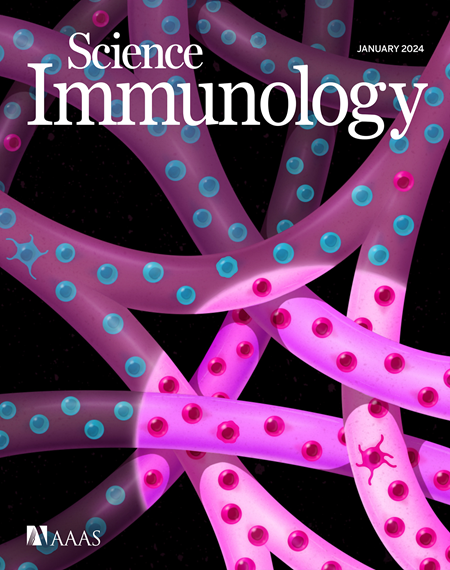宫颈淋巴结免疫景观的改变揭示了多发性硬化症中 Epstein-Barr 病毒的特征
IF 17.6
1区 医学
Q1 IMMUNOLOGY
Science Immunology
Pub Date : 2025-02-21
引用次数: 0
摘要
多发性硬化症(MS)是一种中枢神经系统的自身免疫性疾病,eb病毒(EBV)感染是发病的先决条件。然而,导致多发性硬化症的致病机制仍有待确定。在这里,我们用细针穿刺法描述了新诊断的未经治疗的多发性硬化(pwMS)患者颈深淋巴结(dcln)的免疫景观。通过结合单细胞RNA测序和转录组和表位测序的细胞索引,我们观察到pwMS中记忆B细胞增加,生发中心B细胞减少,克隆性降低。双阴性记忆B细胞在转录上与eb病毒感染的B细胞相似的pwMS中增加。此外,在pwMS的一个子集中检测到ebv靶向记忆CD8 T细胞。我们还检测到dcln中EBV DNA增加,患者唾液中病毒载量升高。这些发现表明ebv驱动的B细胞失调是MS发病的关键机制。本文章由计算机程序翻译,如有差异,请以英文原文为准。
Altered immune landscape of cervical lymph nodes reveals Epstein-Barr virus signature in multiple sclerosis
Multiple sclerosis (MS) is an autoimmune disease of the central nervous system, and Epstein-Barr virus (EBV) infection is a prerequisite for developing the disease. However, the pathogenic mechanisms that lead to MS remain to be determined. Here, we characterized the immune landscape of deep cervical lymph nodes (dcLNs) in newly diagnosed untreated patients with MS (pwMS) using fine-needle aspirations. By combining single-cell RNA sequencing and cellular indexing of transcriptomes and epitopes by sequencing, we observed increased memory B cells and reduced germinal center B cells with decreased clonality in pwMS. Double-negative memory B cells were increased in pwMS that transcriptionally resembled B cells with a lytic EBV infection. Moreover, EBV-targeting memory CD8 T cells were detected in a subset of pwMS. We also detected increased EBV DNA in dcLNs and elevated viral loads in patient saliva. These findings suggest that EBV-driven B cell dysregulation is a critical mechanism in MS pathogenesis.
求助全文
通过发布文献求助,成功后即可免费获取论文全文。
去求助
来源期刊

Science Immunology
Immunology and Microbiology-Immunology
CiteScore
32.90
自引率
2.00%
发文量
183
期刊介绍:
Science Immunology is a peer-reviewed journal that publishes original research articles in the field of immunology. The journal encourages the submission of research findings from all areas of immunology, including studies on innate and adaptive immunity, immune cell development and differentiation, immunogenomics, systems immunology, structural immunology, antigen presentation, immunometabolism, and mucosal immunology. Additionally, the journal covers research on immune contributions to health and disease, such as host defense, inflammation, cancer immunology, autoimmunity, allergy, transplantation, and immunodeficiency. Science Immunology maintains the same high-quality standard as other journals in the Science family and aims to facilitate understanding of the immune system by showcasing innovative advances in immunology research from all organisms and model systems, including humans.
 求助内容:
求助内容: 应助结果提醒方式:
应助结果提醒方式:


